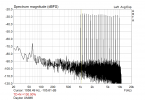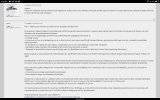I noticed the same kind of issue on my Monacor measurement mic (pronounced H2, and a ton of noise, too), and ultimately resorted to a large-diaphragm condenser, the Thomann SC 400, which happens to have a fairly flat on-axis response - definitely not intended as a measurement mic but workable if you keep a certain distance (to keep proximity effect at bay, it's a cardioid after all) and aim the mic precisely. At least since it's a more directional mic, it can also be placed further away than an omni would. And with plenty of space inside the mic body, there is space for a slightly more than bare minimum amplifier circuit with actually decent level handling, something not necessarily a given for pencil condensers (the all single-ended Oktava MK012 circuit comes to mind, but really it's likely to be quite common given the cramped quarters inside of the things; a "jangling keys" test may be revealing, the IMD was quite audible with my Thomann SC 140 pencil condensers).
Using an SM58 would be sort of like that (its 1" element is right in that territory size wise) except response on dynamics tends to get pretty ragged up top and fall off starting somewhere around 100 Hz on the bottom end (if that). You may be able to calibrate some of that out but getting enough resolution for a precise match may be tough.
The one I would try in terms of "not actually sold as a measurement mic" is a
Line Audio OM1. It's not even all that expensive. They've got very limited distribution though.
I don't think any inexpensive mic with a 1/4" electret capsule is going to be a distortion king. The typical 2-pin capsules are generally going to use a JFET in common source configuration, which is what prompted the
Linkwitz capsule mod in the first place. (The more electronically inclined may get a kick out of the cascoding approach to JFET linearization
as suggested by John Conover. No idea how much use this has seen.) Something using a Primo EM273 10mm capsule would be a lot more interesting, as that exposes both JFET drain and source among its 3 connections. (Perhaps said OM1 is using that as a basis plus some electronics to iron out the response.) I've also seen 3-pin capsules from Sennheiser IIRC, but again I don't expect those to be bargain basement priced.
MEMS microphones have come a fairly long way and may also be worth considering. I've seen some larger ones with both better level handling and lower noise than traditional small electret capsules, even rivalling lesser SDCs. Ever noticed that the microphones on smartypants phones these days are actually pretty good?



